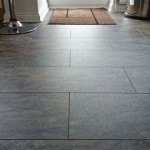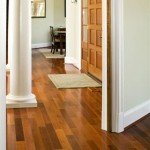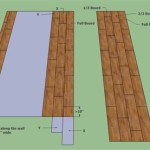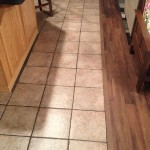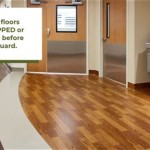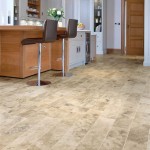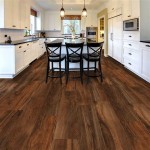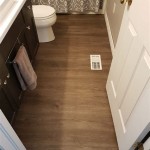```html
What Is Best To Clean Vinyl Flooring
Vinyl flooring, known for its durability, affordability, and aesthetic versatility, is a popular choice for both residential and commercial spaces. However, like any flooring material, it requires regular cleaning to maintain its appearance and prevent the accumulation of dirt, grime, and stains. Understanding the best methods and cleaning agents is crucial to ensuring the longevity and optimal condition of your vinyl floors. The goal is effective cleaning without causing damage or degradation to the flooring material itself.
This article will explore various cleaning approaches, examining their suitability for different types of vinyl flooring and levels of soiling. It will also highlight important considerations regarding cleaning products, techniques, and preventative measures to keep your vinyl floors looking their best.
Regular Maintenance: The Foundation of Clean Vinyl
The most effective approach to cleaning vinyl flooring is preventative maintenance. This involves establishing a routine that minimizes the buildup of dirt and debris, thereby reducing the need for intensive cleaning methods. Regular maintenance primarily focuses on dry cleaning techniques.
Sweeping or Vacuuming: Daily or every-other-day sweeping or vacuuming is paramount. Use a soft-bristled broom or a vacuum cleaner with a hard floor attachment. Avoid using vacuum cleaners with beater bars, as these can scratch or dull the surface of the vinyl. The aim is to remove loose dirt, dust, and pet hair before they become embedded in the flooring or ground in by foot traffic.
Doormats and Rugs: Placing doormats at entrances and rugs in high-traffic areas, such as hallways and kitchens, can significantly reduce the amount of dirt and debris tracked onto the vinyl flooring. Choose mats and rugs that are non-staining and have a non-slip backing to prevent accidents. Clean these mats and rugs regularly as well.
Immediate Spill Cleanup: Addressing spills immediately is crucial to prevent staining and potential damage to the vinyl flooring. Use a clean, absorbent cloth or paper towel to blot up the spill. Avoid rubbing, as this can spread the spill and potentially grind it into the flooring. For sticky spills, use a damp cloth to wipe away any residue.
Effective Wet Mopping Techniques
While dry cleaning is essential for daily maintenance, wet mopping is necessary to remove more stubborn dirt, grime, and stains. However, the key is to do so correctly, selecting the appropriate cleaning solutions and using proper techniques to avoid damaging the vinyl.
Choosing the Right Cleaning Solution: The best cleaning solution for vinyl flooring is often a mild mixture of warm water and a pH-neutral cleaner. Avoid using harsh chemicals, abrasive cleaners, or solvents such as ammonia, bleach, or acetone. These substances can damage the vinyl surface, causing discoloration, dulling, or even warping.
Homemade Cleaning Solutions: Several effective homemade cleaning solutions can be used on vinyl flooring. One popular option is a mixture of warm water and white vinegar. The vinegar acts as a natural disinfectant and can help to remove stubborn stains and dirt. Another option is to add a few drops of dish soap to warm water. Be sure to use a mild dish soap that is free of harsh chemicals.
Mopping Procedure: When wet mopping, use a clean mop and wring it out thoroughly to avoid oversaturating the flooring. Excess water can seep into the seams and edges of the vinyl, potentially causing damage. Mop the floor in sections, using a back-and-forth motion. Rinse the mop frequently with clean water to remove dirt and grime.
Drying the Floor: After mopping, it's essential to dry the floor thoroughly. Use a clean, dry towel or mop to remove any remaining water. This helps to prevent water spots and streaks. In well-ventilated areas, the floor may air dry relatively quickly.
Addressing Stubborn Stains and Marks
Despite regular cleaning efforts, stubborn stains and marks can sometimes appear on vinyl flooring. These may require more specialized cleaning techniques and products to remove effectively.
Identifying the Stain: Before attempting to remove a stain, it's important to identify its source. Different types of stains require different cleaning approaches. For example, grease stains may require a degreasing agent, while ink stains may require a solvent-based cleaner.
Specific Stain Removal Techniques: Once the stain is identified, use the appropriate cleaning technique: *
Scuff Marks:
For scuff marks, try using a clean tennis ball or a magic eraser. Gently rub the affected area until the scuff mark disappears. *Grease Stains:
For grease stains, apply a paste of baking soda and water to the affected area. Let it sit for a few minutes, then scrub gently with a soft cloth or brush. *Ink Stains:
For ink stains, try rubbing alcohol or nail polish remover (acetone). However, use these sparingly and test them in an inconspicuous area first, as they can potentially damage the vinyl. *Rust Stains:
For rust stains, a commercial rust remover specifically designed for vinyl flooring may be needed. Follow the manufacturer's instructions carefully. *Adhesive Residue:
For adhesive residue, try using a solvent-based adhesive remover. Again, test in an inconspicuous area first.Gentle Scrubbing: When removing stubborn stains, use a soft-bristled brush or a non-abrasive scrubbing pad. Avoid using harsh scrubbing pads or steel wool, as these can scratch the vinyl surface. Apply gentle pressure and scrub in a circular motion until the stain begins to lift.
Rinsing and Drying: After removing the stain, rinse the area thoroughly with clean water and dry it with a clean towel.
Preventing Future Stains: To prevent future stains, consider applying a vinyl floor sealant or finish. This will create a protective layer that can help to repel stains and make the flooring easier to clean. Consult with a flooring professional to determine the best sealant or finish for your specific type of vinyl flooring.
Protecting Against Furniture Damage: Furniture can leave dents and scratches on vinyl floors. Use furniture pads under the legs of tables, chairs, and sofas to distribute the weight and prevent damage. Avoid dragging heavy furniture across the floor, as this can cause scratches and gouges.
Avoiding Excessive Heat: Vinyl flooring can be susceptible to damage from excessive heat. Avoid placing hot objects directly on the flooring. Use trivets or placemats under hot dishes and appliances. If using a steam cleaner, use the lowest setting possible and avoid prolonged exposure in one area.
Understanding the Different Types of Vinyl Flooring: Different types of vinyl flooring, such as sheet vinyl, luxury vinyl tile (LVT), and luxury vinyl plank (LVP), may have slightly different cleaning requirements. Always refer to the manufacturer's instructions for specific cleaning recommendations.
Sheet Vinyl: Sheet vinyl is a seamless flooring option that is relatively easy to clean and maintain. However, it is important to be careful not to damage the seams, as this can allow water to seep underneath the flooring.
Luxury Vinyl Tile (LVT) and Luxury Vinyl Plank (LVP): LVT and LVP are designed to mimic the look of natural materials like wood and stone. They are typically more durable than sheet vinyl and are more resistant to scratches and stains. However, it is still important to avoid using harsh chemicals or abrasive cleaners.
Testing Cleaning Solutions: Before using any new cleaning solution on your vinyl flooring, it is always a good idea to test it in an inconspicuous area first. This will help to ensure that the cleaning solution does not damage or discolor the flooring.
Professional Cleaning Services: For heavily soiled or stained vinyl flooring, consider hiring a professional cleaning service. Professional cleaners have the expertise and equipment to safely and effectively clean vinyl flooring without causing damage.
Considerations for Pets: Homes with pets require extra attention to cleaning. Pet hair and dander can accumulate quickly on vinyl floors, and pet accidents can cause stains and odors. Clean up pet messes immediately and use a pet-friendly cleaning solution.
Regular Inspection: Periodically inspect your vinyl flooring for signs of wear and tear. Address any issues promptly to prevent further damage. This includes repairing small tears or cracks and replacing damaged tiles or planks.
```
How To Deep Clean Vinyl Floors Practically Spotless

How To Clean Vinyl Floors

How To Clean Vinyl Flooring Without Damaging It Advice From Bob Vila

How To Clean Vinyl Plank Flooring Cutesy Crafts

Acknowledging The Best Way To Clean Vinyl Flooring

The Best Way To Clean Floors Of All Kinds Wood Vinyl Stone And More

How To Deep Clean Linoleum Floors Practically Spotless

How To Clean Vinyl Floors Tarkett

8 Easiest Ways To Clean Vinyl Floors

How To Clean Vinyl Floors The Home Depot
Related Posts

